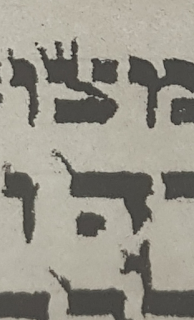צד"י [כתב אר"י] נפסק היו"ד - לענין תיקון
הדין במקרה זה: אם ניכר לעין שיש כאן שתי אותיות, אי אפשר לתקן בתו"מ שלא כסדרן. ואם ספק אזי מועיל קריאת התינוק, ואם קוראו צ' - מותר לתקן בתו"מ.
בנוגע לכתב האר"י - היות שהצ' אינו דומה כל כך לנו"ן [בכתב זה] ויו"ד, משום שהנו"ן כפופה מאוד, והיו"ד הפוכה, יש מקילים.
למעשה אין למהר ולהקל כל כך, אלא רק אם ספק מה הצורה שלפנינו. לפי התמונה הנראית כאן - זה נראה יותר כאות צ'.
היות שההבחנה במקרים אלו גבולית, קשה לסמוך על תמונה בסקן להחליט הדבר [אע"פ שבמקרה שלפנינו היות שהכתב קטן יותר מהתמונה, כמעט ברור שמסקנת הרואה במציאות תהא זהה לרואה בסקן].
ראה גם: https://hebrewstam.blogspot.com/2018/08/blog-post_16.html
ראה גם: https://hebrewstam.blogspot.com/2018/08/blog-post_16.html


Thank you very much for posting and explaining your thoughts, rather then "Paskening" via a digital image.
ReplyDeleteThough, sources would be appreciated too, so when necessary we'll have what to present to the Rov. as recommended by קול סופרים, paragraph 25 in the beginning of his Sefer.
Admittedly this is a lower quality image. In addition, in order to judge whether a split is lehedia or not, one needs to see the original/actual size.
ReplyDeleteIf this isn't considered a letter that may be split into 2 letters, because it's Arizal and the Yud is backwards (and possibly because of the Nun, even though I'd be less inclined to take it into consideration since it does seem to pass for a poorly written Nun (and because I've never seen this brought down (source anyone?) for not considering a split [Bais Yosef] tzadi as not 2 letters) then, if not lehedia, a tinok wouldn't need to be asked.